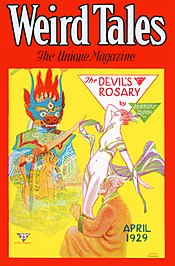Dunwich Horror
| "The Dunwich Horror" | |
|---|---|
 |
|
| Author | H. P. Lovecraft |
| Country | United States |
| Language | English |
| Genre(s) | Horror short story |
| Published in | Weird Tales |
| Publication type | Periodical |
| Media type | Print (Magazine) |
| Publication date | April, 1929 |
"The Dunwich Horror" is a short story by H. P. Lovecraft. Written in 1928, it was first published in the April 1929 issue of Weird Tales (pp. 481–508). It takes place in Dunwich, a fictional town in Massachusetts. It is considered one of the core stories of the Cthulhu Mythos. "The Dunwich Horror" is one of the few tales Lovecraft wrote wherein the heroes successfully defeat the antagonistic entity or monster of the story.
In a letter to August Derleth, Lovecraft wrote that "The Dunwich Horror" "takes place amongst the wild domed hills of the upper Miskatonic Valley, far northwest of Arkham, and is based on several old New England legends — one of which I heard only last month during my sojourn in Wilbraham," a town east of Springfield. (One such legend is the notion that whippoorwills can capture the departing soul.)
In another letter, Lovecraft wrote that Dunwich is "a vague echo of the decadent Massachusetts countryside around Springfield — say Wilbraham, Monson and Hampden." Robert M. Price notes that "much of the physical description of the Dunwich countryside is a faithful sketch of Wilbraham," citing a passage from a letter from Lovecraft to Zealia Bishop that "sounds like a passage from 'The Dunwich Horror' itself":
The physical model for Dunwich's Sentinel Hill is thought to be Wilbraham Mountain near Wilbraham.
Researchers have pointed out the story's apparent connections to another Massachusetts region: the area around Athol and points south, in the north-central part of the state (which is where Lovecraft indicates that Dunwich is located). It has been suggested that the name "Dunwich" was inspired by the town of Greenwich, which was deliberately flooded to create the Quabbin Reservoir, although Greenwich and the nearby towns of Dana, Enfield and Prescott actually weren't submerged until 1938. Donald R. Burleson points out that several names included in the story—including Bishop, Frye, Sawyer, Rice and Morgan—are either prominent Athol names or have a connection to the town's history.
...
Wikipedia
